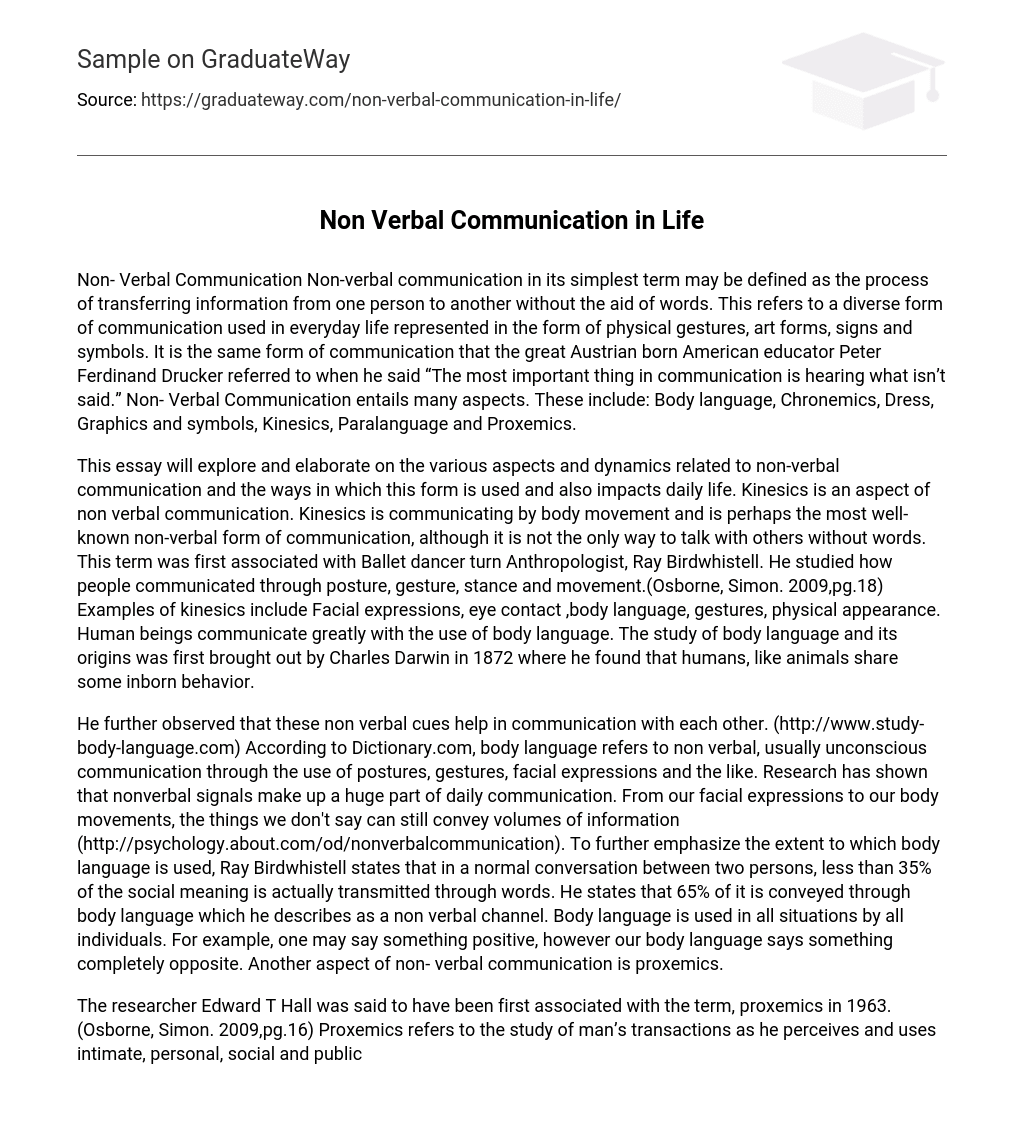Non- Verbal Communication Non-verbal communication in its simplest term may be defined as the process of transferring information from one person to another without the aid of words. This refers to a diverse form of communication used in everyday life represented in the form of physical gestures, art forms, signs and symbols. It is the same form of communication that the great Austrian born American educator Peter Ferdinand Drucker referred to when he said “The most important thing in communication is hearing what isn’t said.” Non- Verbal Communication entails many aspects. These include: Body language, Chronemics, Dress, Graphics and symbols, Kinesics, Paralanguage and Proxemics.
This essay will explore and elaborate on the various aspects and dynamics related to non-verbal communication and the ways in which this form is used and also impacts daily life. Kinesics is an aspect of non verbal communication. Kinesics is communicating by body movement and is perhaps the most well-known non-verbal form of communication, although it is not the only way to talk with others without words. This term was first associated with Ballet dancer turn Anthropologist, Ray Birdwhistell. He studied how people communicated through posture, gesture, stance and movement.(Osborne, Simon. 2009,pg.18) Examples of kinesics include Facial expressions, eye contact ,body language, gestures, physical appearance. Human beings communicate greatly with the use of body language. The study of body language and its origins was first brought out by Charles Darwin in 1872 where he found that humans, like animals share some inborn behavior.
He further observed that these non verbal cues help in communication with each other. (http://www.study-body-language.com) According to Dictionary.com, body language refers to non verbal, usually unconscious communication through the use of postures, gestures, facial expressions and the like. Research has shown that nonverbal signals make up a huge part of daily communication. From our facial expressions to our body movements, the things we don’t say can still convey volumes of information (http://psychology.about.com/od/nonverbalcommunication). To further emphasize the extent to which body language is used, Ray Birdwhistell states that in a normal conversation between two persons, less than 35% of the social meaning is actually transmitted through words. He states that 65% of it is conveyed through body language which he describes as a non verbal channel. Body language is used in all situations by all individuals. For example, one may say something positive, however our body language says something completely opposite. Another aspect of non- verbal communication is proxemics.
The researcher Edward T Hall was said to have been first associated with the term, proxemics in 1963.(Osborne, Simon. 2009,pg.16) Proxemics refers to the study of man’s transactions as he perceives and uses intimate, personal, social and public space in various settings. Proxemics is seen in everyday life and the differences in the use of space can either cause anxiety or relaxation. For example, a teacher may be marking books in class, all students crowd the teacher pushing their books all together at him/her. The teacher may become irate or even annoyed and send each student to their seat as he/she feels as if the students have invaded his/her personal pace. This is proxemics at work. You don’t have to say anything for someone to know how you feel. Based on how close or faraway you are from someone can communicate how your interest in that person. Chronemics deals directly with the nonverbal communication delivered through time/ chronology.
Chronemics states that the way we perceive time, structure time and react to time is a powerful communication tool. According to Chronemics, the timing of any action as well as the tempo of communication within an interaction contributes to the process of non verbal interaction. (http://www.buzzle.com/articles/nonverbal-communication.html). It involves pacing, waiting and the effect that the time has on the behaviour of a person. Chronemics is used to create effect or to communicate amusement or to suggest the importance of a piece of information. When someone stands to speak, they may say something and then pause for a while in order for the listener to reflect on what was said. This is Chronemics at work. Dress is a part of non-verbal communication that says a lot about you. Dress as described by an unknown source states that “We act the way we dress. Neglected and untidy clothes reflect a neglected and untidy mind.” The way we dress plays a very important role in the kind of message we communicate to the persons around us. Dress can tell ones social status, one’s emotions, the kind of job one does. Dress can also communicate the territory to which we belong and also the kind of culture we practice. The rock star tight leather jeans and jacket look cannot get you a job as a managing partner at a law firm as this look will not communicate professionalism.
Therefore, dress code says a lot about an individual. Another well known aspect of non verbal communication is Graphics and Symbols. Graphics and Symbols may be defined as the presentation of data in a graphical format. Many subject areas use graphic and symbols to assist in effective communication. Also many business places and manufacturers use graphics and symbols to caution individuals or to help them to clearly understand what is being brought across. Graphics and symbols are used in many areas and they effectively communicate. Paralanguage describes vocal features that accompany speech and contribute to communication but are not generally considered to be part of the language system, as vocal quality, loudness, and tempo: Dress code says a lot about an individual sometimes also including facial expressions and gestures. Para language is used to convey emotion.
For example, the emoticons one use in email via the internet. One conveys your emotions but non verbally. Therefore para language is another form of non verbal communication. “Actions speak louder than words,” is a phrase commonly used in society. This refers to non verbal communication and despite its many divisions, it is a very effective form of communication. Therefore, one can communicate effectively without words.





